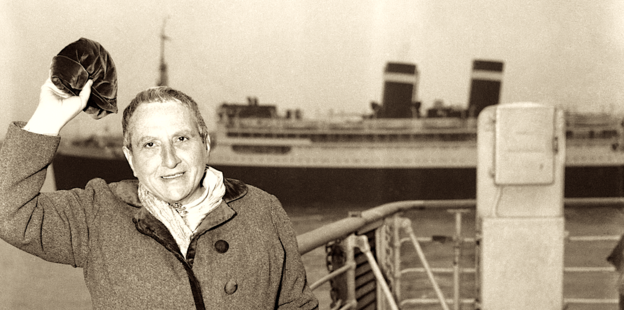
The fuck-you bow (PoemTalk #90)
Gertrude Stein, 'How She Bowed to Her Brother'

Maxe Crandall, Julia Bloch, and Sarah Dowling joined Al Filreis to talk about Gertrude Stein’s “How She Bowed to Her Brother.” It was written in late 1931. The text can be found in A Gertrude Stein Reader, edited by Ulla Dydo (564). On PennSound’s Gertrude Stein page, which has been edited and annotated by Dydo, one can hear a recording of Stein performing the first section of the three-section poem. The recording was done in 1934, during Stein’s visit to New York that year.
 Stein here experimented with the period as a punctuation mark, using it sometimes as one would a comma and at other times when conventionally no punctuation at all would appear. So the reading (aloud — but also, we think, it’s the case with silent reading) is typified by frequent disruptive pauses and stops, adding to the already strong effect of fragmentation. Above from left to right: Sarah Dowling, Julia Bloch, Maxe Crandall.
Stein here experimented with the period as a punctuation mark, using it sometimes as one would a comma and at other times when conventionally no punctuation at all would appear. So the reading (aloud — but also, we think, it’s the case with silent reading) is typified by frequent disruptive pauses and stops, adding to the already strong effect of fragmentation. Above from left to right: Sarah Dowling, Julia Bloch, Maxe Crandall.
“This is a poem that is interested in relationships as performance,” observes Maxe. The bow, all four PoemTalkers agreed, was a gesture of theater that can be interpreted any number of ways. Gertrude Stein either did or did not bow to her brother, Leo Stein, as they encountered passing views of each other accidentally in Paris traffic one day many years after the sister and brother, just two years apart, had had a permanent falling out. The ambivalence of the gesture in the Stein biography — Maxe observes, as author of an in-progress biographical study of Stein and men — is amplified in the poem. The frequent use of the period only adds to the ambiguity of each restatement of the bow in the poem.
Sarah offers a reading of several lines of the poem in which it seems clear that there was some reciprocality in the bowing. Al naively wonders whether a bow can be ironic, and then, with quick unanimity, the group affirms that indeed there can be what Al dubs a “fuck-you bow.” Julia reminds us that there is “another brother” in the poem (Maxe helps us identify this as Michael Stein), such that soon it is not even clear which brother is being doubted. “All of a sudden,” Julia notes, “I get the impression of all these people, in the scene.” The bowing of Gertrude to Leo “is modernist silence because it’s a modernist moment. It’s Paris, in the 1930s!”
Toward the end of the discussion we attempt to make sense of what Stein calls in this poem a “union between reading and learning.” Sarah wonders if Stein is lamenting the situation: if reading and learning have converged, “now everyone reads but no one thinks.” Stein might be looking back fondly at a prelapsarian moment (with family as a touchstone or analogy or metaphor of relationship but also a relational literality) when there was “an intense bond that was taking place between reading and learning” deeply inside the Stein family — and no separation, in this ideal mode, between intellectual functions.
After Sarah offers this reading of the poem’s marking the significance of the break in the family, Al pushes toward a psychoanalytic reading of early, premodern unindividuated or unalienated intellection, a phase the end of which is signaled by the open gestural bowing. Yet, as Sarah notes, as much as that prelapsarian ideal familial connection was precious, Stein needed to mark the distance in order to continue to develop as an artist on her own — she needed, in short, to stop bowing to her brothers. There are as many ways to see in this poem that Stein did not bow to her brother as ways that she did.
This ninetieth episode of PoemTalk was recorded and engineered by Zach Carduner and Tyler Burke and edited by Amaris Cuchanski. Please subscribe to PoemTalk in iTunes. If you subscribe, you will automatically get each new PoemTalk as it appears monthly.